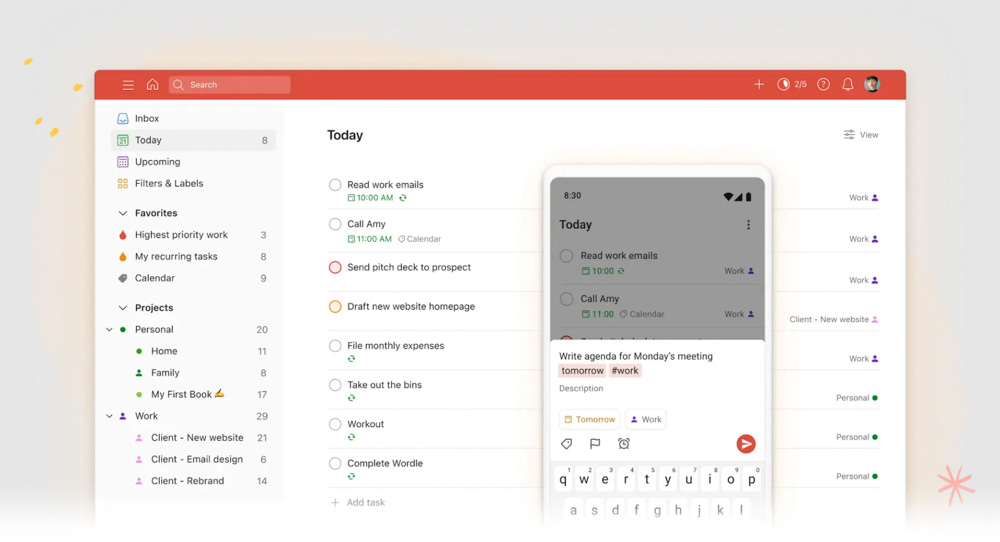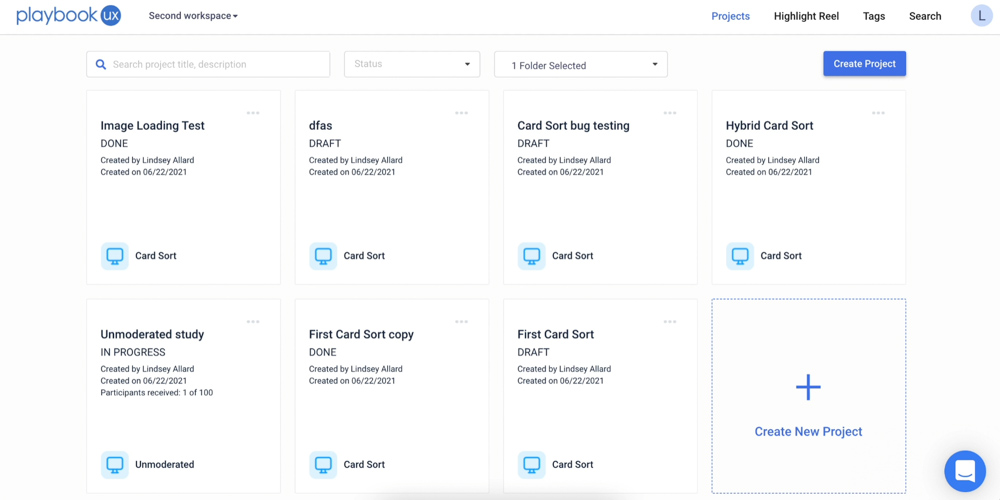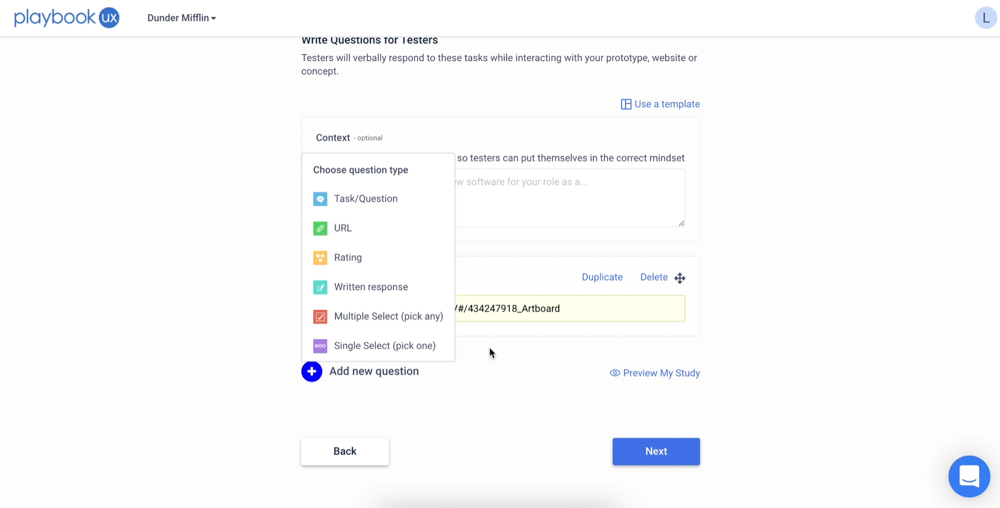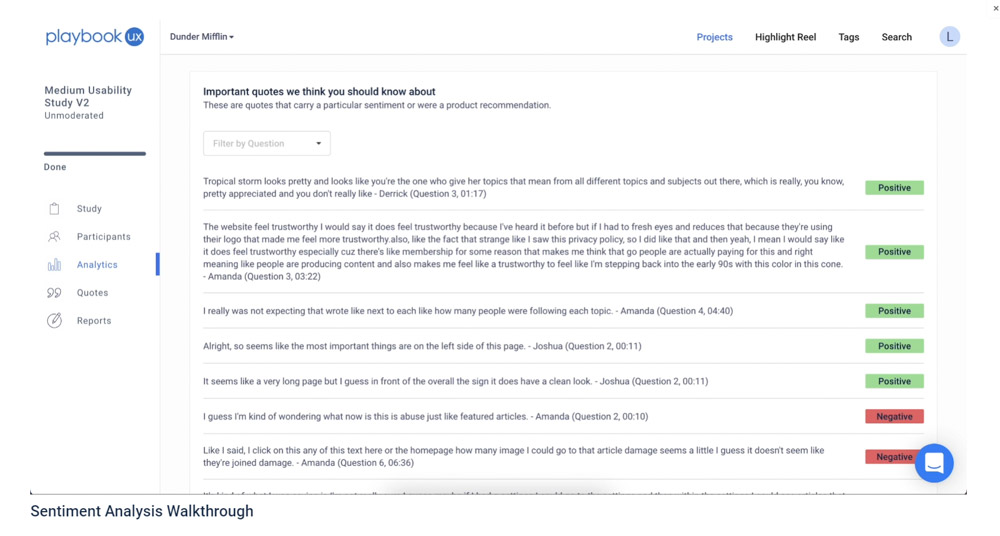Unlock Your Product’s Potential: How Concept Testing Can Help You Find the Best Ideas

Image source: Pexels
Many companies struggle to find unique ideas regarding new product development. At the same time, these companies want to ensure that the final product is something consumers want to use or buy. It’s not easy, that’s for sure – according to research carried out by McKinsey Global Institute, 25-45% of products launched each year fail.
That’s why concept testing is so helpful in new product development. It’s a process that helps you evaluate your ideas before investing resources into developing a new product.
Using a dedicated user testing platform is the easiest way to carry out concept testing. Our PlaybookUX is a video-based user research software that helps you run moderated and unmoderated concept studies and create various concept testing questions. With PlaybookUX, you can validate any product idea and determine if it fits the market. To see how it works, start your free trial today.
This article will explain concept testing, its benefits and drawbacks, types of concept testing methods, and how you can use PlaybookUX to run your concept tests. Let’s start with some essential details.
What is concept testing?
Concept testing is a method for validating the feasibility of an idea, product, or service. It involves creating a hypothetical scenario and measuring the user’s response.
In concept testing, you ask users to use a hypothetical product or service, describe how they feel about it, and note their perceptions of the product. You then use these data sets to evaluate whether there is any interest in the product or service among potential users. If there is, you can move into the next stage of development. If not, you can simply discard the idea.
You can run concept tests before the project enters the development phase. In most cases, you use a concept testing survey or a focus group of a few people recruited and trained to use the product concept in realistic scenarios. You can also use a specialized user testing platform such as our PlaybookUX, which makes things considerably easier by doing many menial tasks for you, such as scheduling or transcribing.
You can also conduct concept testing during product development to evaluate whether new features make sense from your customers’ perspectives. Together with market research, it’ll help you identify potential target market shifts that may affect your business and generally keep a finger on the pulse of your target customers.
You now know the definition of concept testing. But how exactly can this method benefit your business?
Advantages of concept testing

Image source: Freepik
Here are some of the critical benefits of concept testing – why you shouldn’t neglect this step during product development.
- Innovation – when trying to develop an innovative product or service, knowing whether your idea will work can be difficult. By testing the concept with potential customers early on, you can get valuable feedback to help guide the development process.
- Saving time – while concept testing requires time and effort, it can save time in the long run since it allows you to learn what works and what doesn’t. As you build out your MVP (Minimum Viable Product), you won’t have to start from scratch because you’ve already learned some lessons from previous tests.
- Spot problems and areas of improvement – as you build out your MVP and refine it based on customer feedback, it will become more evident whether your product has value for the target audience. You can also get insights regarding specific aspects of your solution or its pricing. It’s important because if no one wants a product or a feature, then there’s no point in continuing the development.
- Finding support for an idea – you can also use concept testing to find support among the stakeholders in your company for an idea you consider valuable.
However, as beneficial as concept testing is, it won’t solve every problem, and it also has some critical limitations you need to consider.
Limitations of concept testing
Concept testing helps you improve your product, but there are some things you have to keep in mind when conducting it:
- It doesn’t measure actual consumer behavior – it can only tell whether people understand your product’s basic premise and whether they find it attractive.
- It can’t tell you whether your product will succeed or fail – It cannot predict how consumers will respond to the solution once you launch it.
- It has to follow specific criteria – selecting the parameters and metrics you will use for testing is essential.
- It can be costly in terms of time and money – depending on how you design the test, concept testing can be pretty expensive and time-consuming.
- It has limited accuracy – by its very nature, concept testing isn’t a method for generating 100% accurate data.
When to start with concept testing
You should start running concept tests before you begin the product development phase, as the data and insights you gather are supposed to inform and guide this process.
This way, you’ll know whether there’s any genuine interest in the product you have in mind. You can also use concept testing to identify critical markets you should be interested in and niches in these markets that your solution can occupy.
4 concept testing methods

Image source: Freepik
You can use various concept testing methods to achieve different results and goals. Here are the most commonly used techniques.
1. Monadic testing
You can conduct monadic testing to get an in-depth evaluation of several concepts. You do this by dividing your test audience into several groups and running short, focused sessions with each. You present a different concept to each group and ask questions and follow-up questions about its various attributes, such as look, feel, price, and so on.
This study allows you to get in-depth feedback regarding a few concepts without making the sessions too long. It’s a quick way to evaluate your product ideas and check which of them are worth pursuing.
2. Comparison testing
During comparison tests, you present several concepts to the same group and ask people to evaluate each of them, usually by rating or ranking ideas.
Comparison testing is an excellent way to highlight each idea’s advantages, disadvantages, and differences. It provides a clear set of data that is easy to use in product development but doesn’t give you in-depth context. For example, you don’t know why users preferred one option over another.
3. Sequential monadic testing
Sequential monadic tests are a mixture of comparison testing and monadic testing. You divide your testers into several groups, but instead of showing a single concept to each group – like in monadic testing – you present everyone with all the ideas.
The concepts are displayed one after the other. You show them in a randomized order to each group to decrease the chance that people will be biased. After that, can you ask people questions, just like during a monadic test.
With sequential monadic tests, the focus groups don’t need to be big, and you can evaluate multiple concepts at the same time. It’s a very cost-effective concept testing method. The downside is that you have to ask plenty of questions to get all the answers you want, which can affect the completion rate negatively.
4. Proto-monadic testing
Proto-monadic tests have two phases. The first one is a sequential monadic test, as described above, during which you ask respondents to evaluate multiple concepts by asking them various questions about them. The second part is a comparison test – you ask people to rate the presented options to see which they prefer.
You then compare the data from both tests, determine their compatibility, and draw conclusions. This method is a good choice when trying to understand what drives people to like a specific option and dislike another.
How to choose the right concept testing method?

Image source: Freepik
The choice of concept testing method will usually depend on the goals you want to achieve, as well as time and budget constraints.
For example, you can use comparison testing when you want to check which ideas users prefer over others quickly, but you don’t need a lot of in-depth data. A monadic or sequential monadic test will be a good option if you don’t want to spend too much money but have a few concepts to validate.
6 steps to run a concept test
Here are the basic steps you need to follow to run a successful concept test:
- Set goals – before you do anything else, you need to specify what goals you want to achieve with your concept test.
- Create questions and script – the second step requires you to create a script for the test and questions you will ask your participants. An effective concept testing survey is crucial for your success.
- Hire participants – now it’s time to find the right people. You can run a standard recruitment process or invest in a platform like PlaybookUX. If you do, we’ll do this part for you – you can just specify what kind of testers you’re looking for, set other details of your study, and focus on other tasks.
- Determine how you’ll run the test – you’ll usually begin by introducing yourself and the concept of the test. After that, you can start asking preliminary questions regarding demographics, which will prove helpful later. Determine what the participants know of your brand and your competitors’ brands. Then move on to questions about your concept, starting with the most general ones.
- Choose quantitative metrics – getting some quantitative data during the test is essential. Otherwise, the results may be hard to analyze and use. For example, in many concept tests, you can ask people to assign point scores and ratings, which will help you put the participants’ answers in the proper context.
- Review the data – every concept test needs to end with an in-depth review of gathered data. You have to draw conclusions and insights you can use to guide your product development in the right direction.
3 real-world examples of concept testing
Here are some interesting real-world concept testing examples. It is how companies all around the world use this process.
1. Lego

Image source: YouTube
The well-known toy manufacturing company Lego found out that only 10% of its products were bought by or for girls. The organization decided to use concept testing to evaluate whether it’s a market they can tap.
It turned out it was. However, to be successful, products had to be different. Girls were more interested in building environments and interior layouts than constructing a single structure, which was what boys liked.
In the end, Lego created a new product range, which turned out to be a huge success – the market for such toys for girls tripled in just two years.
2. Todoist

Image source: Capterra
Todoist – a company known for its to-do list software – noticed that many of its users asked for a Boards feature that would allow them to visualize their projects and organize them easier.
The company wanted to ensure that the feature provides what customers have been asking for, so they contacted 17 people who requested it directly and conducted 30-minutes long one-on-one concept testing sessions. They’ve asked questions regarding the expected workflow improvement, the interface, and other wishes and ideas.
Once again, concept testing proved valuable. It allowed Todoist to ship a very well-received beta version, which led to a successful public launch.
3. Tesla

Image source: YouTube
Tesla is another example of concept testing used to good effect. Elon Musk’s company did it during the release of Model 3. The approach was different than in the case of other companies. Concept testing was a tool that helped secure funding.
Tesla used concept testing to gain customer approval. They presented participants with Model 3’s concept to help them understand the vehicle’s distinctive attributes and advantages. When people learned of the car’s features, Tesla asked them whether they wanted to put down a deposit.
The method was a huge success, and Tesla raised $400 million. Thus, concept testing allowed Tesla to gain critical feedback and funding from customers, allowing the company to move forward with Model 3’s release.
How to test multiple concepts with PlaybookUX

PlaybookUX is a web-based and video-based platform you can use for user research, including concept testing. It also allows you to run various other usability tests: unmoderated tests, moderated interviews, tree testing and card sorting, etc. You can use PlaybookUX for:
- Concept testing
- Usability testing
- Prototype testing
- Evaluating mobile web pages
- Testing web apps
- Evaluating marketing messages and other kinds of content
- Defining target audience
To run a concept test via PlaybookUX, you must choose the right option from our dashboard. After that, you can specify context and details regarding your audience, determine the context of the study, and create your concept test survey – write the questions you want to ask your test participants.
You can also select question and answer types – single select, multiple select, rating, written response, and so on.
After the test session, you will access charts with details regarding your participants: their jobs, genders, ages, industries they work in, etc.
Using PlaybookUX, you can develop notes, transcripts, and highlights in a snap. You may use PlaybookUX usability tests to learn more about your customers and verify ideas, which will assist you with content creation.
Some of the more monotonous tasks, like transcriptions, and scheduling tests, are automated in our system. You can save time and invest it in more critical activities.
You can also use PlaybookUX as your user research repository. With our powerful search engine, indexing and tags, you can quickly find whatever you need in your workspace.
What’s more, with our platform, you don’t need to pay for an additional license to do that, as you have to in the case of EnjoyHQ or Dovetail. You’ll save time and make things considerably easier for yourself.

PlaybookUX can also help you analyze the collected data to gain meaningful insights and identify negative trends. For example, it identifies positive and negative quotes in sentiment analysis to see what you should address first and what the users found challenging. You can easily tag themes and use reactions to keep track of these patterns.
Concept testing: Final words
There are many reasons to conduct concept testing. It helps you understand the feasibility of your product and get valuable insights from potential users. It’ll allow you to understand the best way to present your product to the market and see where you need to make changes based on user reactions. It’s an invaluable tool in the arsenal of most businesses.
However, you should also keep some things in mind regarding concept testing. You have to choose the right target audience and metrics and ensure that you thoroughly understand the type of concept you want to test. Otherwise, you risk burning money for nothing.
Investing in the right tool is a great way to make things easier. A platform such as our PlaybookUX will help you with many steps of the concept testing process. You’ll quickly set your study and recruit participants without effort. Our solution will automate scheduling and transcribing and help you quickly search through data. It’ll even serve as your research repository. If you want to see PlaybookUX in action, sign up and start our 7-day free trial!
Concept testing: FAQ
Here are answers to some of the most popular questions regarding concept testing that you can find on the Internet.
What is meant by concept test?
Concept testing is a process of evaluating ideas for products, services, or specific features. You conduct it by creating a hypothetical scenario about a product or service and then asking your potential users what they think of your ideas.
What is the purpose of concept testing?
Entrepreneurs use a concept test to determine whether a new product idea has merit. It’s similar to a prototype as it helps weed out bad ideas and refine the best ones. You should use concept testing to evaluate whether customers are interested in your new idea, to see if there is demand for the potential product and if it is something people would pay for.
What is concept testing in programming?
You can use concept testing to evaluate software products, just like you’d do with other products. Testing will help you find issues in your applications. You can use the acquired information to make them more effective and user-friendly. When you have better usability and less friction between users and your program, people are more likely to engage with it. It’s helpful for your business, and you can conduct it efficiently using PlaybookUX. Sign up and start 7-day free trial!
Speak to high quality people
